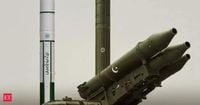In a dramatic escalation of tensions between India and Pakistan, the Fatah-II missile, a guided artillery rocket system developed by Pakistan, was intercepted over Sirsa, Haryana, on May 10, 2025. This incident marks a significant moment in the ongoing conflict between the two nuclear-armed neighbors, with both sides accusing each other of unprovoked attacks.
The Fatah-II missile, which boasts a range of approximately 400 kilometers, is designed for precision strikes against military positions, radar installations, and logistics facilities. It is an upgraded version of the earlier Fatah-I system, first tested by Pakistan's army in December 2021. The missile can carry conventional warheads and is equipped with advanced avionics and an inertial satellite navigation system, reportedly achieving a Circular Error Probable (CEP) of less than 10 meters. This high level of accuracy allows it to effectively engage high-value targets deep within enemy territory.
According to reports, Pakistan launched the Fatah-II missile under 'Operation Bunyan ul Marsoos,' allegedly targeting Delhi. However, it was intercepted by Indian air defense systems before reaching its intended destination. The missile's interception was confirmed by defense sources, who emphasized that it posed no threat to civilian areas or critical infrastructure.
Meanwhile, the situation on the ground remains volatile. Early on Saturday morning, explosions were reported across multiple areas in Pakistan, with a Reuters witness confirming that three military sites were hit. This comes in the wake of reports that Indian forces struck at least four airbases in Pakistan, including Nur Khan, Mureed, and Shorkot, as retaliation for a series of drone and missile attacks launched by Pakistan earlier that day.
In a statement, the Indian Ministry of Defence highlighted the growing threat posed by unmanned aerial vehicles, noting that drones had been sighted at 26 locations along the International Border and the Line of Control (LoC) with Pakistan. These locations included Baramulla, Srinagar, and Jaisalmer. The ministry also reported that an armed drone strike in Punjab's Ferozpur had left three family members injured, with one in critical condition.
As tensions escalated, Indian air defense systems intercepted multiple drones targeting strategic air bases, successfully neutralizing the aerial threats. Reports indicate that Indian forces shot down several drones in Amritsar and Jaisalmer, as heightened surveillance and readiness were implemented across the region.
In response to the ongoing conflict, security measures have been ramped up across northern and western India, with the temporary closure of 32 airports announced to ensure civil aircraft operations remain safe. Blackout orders were issued in parts of Punjab and Jammu and Kashmir following reports of drone activity and loud noises, further heightening the sense of urgency and caution among residents.
Pakistan, for its part, has accused India of launching airstrikes on its territory, claiming that its airbases were targeted by Indian suicide drones and missiles. The Pakistan military spokesperson, Lt Gen Ahmad Sharif Chaudhry, confirmed that Nur Khan air base, located just 10 kilometers from Islamabad, was among the facilities attacked. He stated that while some missiles were intercepted, the situation remains tense.
As the standoff continues, the international community is closely monitoring the developments. U.S. President Donald Trump has called for both nations to de-escalate the situation, with Secretary of State Rubio reportedly in communication with leaders from both sides. The potential for further escalation remains high, as both countries maintain their military postures along the border.
The Fatah-II missile incident underscores the precarious nature of India-Pakistan relations, with both sides poised for further military action. While Pakistan's missile capabilities have been demonstrated, India’s robust air defense systems have effectively neutralized immediate threats. As the situation develops, the implications for regional stability and security are significant.
In summary, the Fatah-II missile launch and its interception mark a critical juncture in the ongoing conflict between India and Pakistan. With both nations engaging in military operations and retaliatory strikes, the potential for escalation remains a pressing concern for the international community. The situation is being monitored closely, with hopes for a peaceful resolution diminishing amid the rising tensions.






